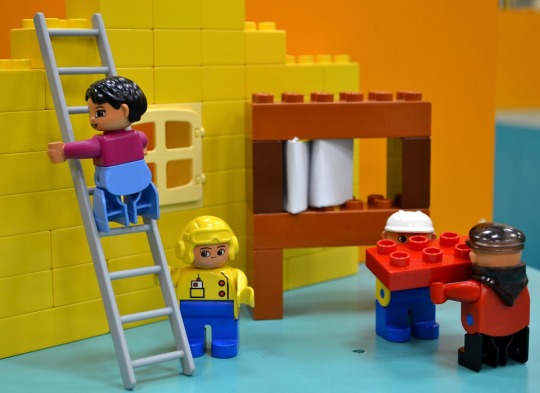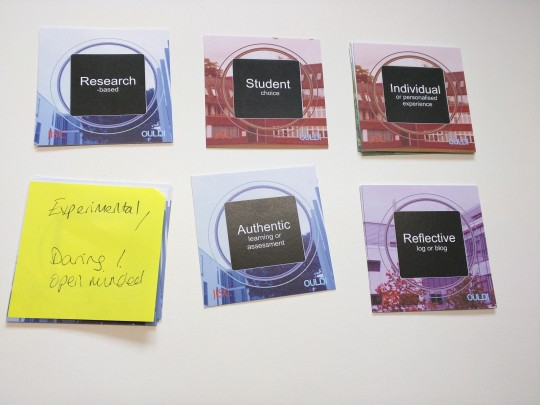A couple of weeks ago I had the pleasure of spending the day with Head of Business School, Jeremy Richards to go through the course design process for one of the modules on the new Leasing and Asset Finance, MA.

This kind of course design can be described as a course or learning design retreat. It is a day, or two depending on requirements, where the teaching team can get away from their desks and the distractions of the day to day. With support from a range of specialist staff they build or re-design taught modules by working through learning design activities which focus on elements of the module; all building up to a storyboard, an action plan and some prototype learning activities.
In practice, Jeremy found that the first stages of the process worked well, and helped to either re-define, refine, or solidify ideas that have been thought of before the workshop. We were building a module that had already been validated so were limited in terms of things could we change ie. learning outcomes, assessment weightings etc.
First of all we worked through the ‘Mission Statement’ part of the process where Jeremy boiled down into a couple of sentences what the overall aim of the module is. Doing this helps to focus the mind on the essential aspects without getting caught up with the details.
Next up, we jumped straight into an activity to think about how the module will be run, and what the main ethos, or the main ‘look and feel’ of it is. We did this by going through the Jisc / Open University Learning Design Initiative card sort activity where we sorted the cards into three piles; the ‘yes’, the ‘maybe’, and the ‘no’ piles. The idea is to decide if the wording on the card is something to include in the design of the module, or not. Once we had the three piles, we were ruthless and narrowed it down to 6 ‘must haves’. You can also create your own cards if there isn’t one that describes something you need.

This activity:
- enables the teaching team to work towards a consensus on the type of learning experience they want to create
- provides a common language to help talk about how they like to teach – particularly for teaching strategies that are based on more of a tacit experience. Sorting the cards stimulates discussion about them: what do you mean by …? how does that work? why is that the best approach? This discussion is useful for skill sharing and ideas for personal development, as well as narrowing down the most effective approaches for the context.
- brings the learners into the heart of the conversation, as choices need to be made about what learning approaches they might use, and what kinds of support they might need.
- helps to ensure that the team are considering all the elements that make up a balanced module.
Next up comes ‘constructive alignment and backwards design’. The idea behind this stage is to jump to the end of the module, or stage within the module, and think about what it is that you’re aiming for the student to have achieved, how they might get to that point, and what knowledge they need to have or gain to get there. This focuses the mind on the aims and outcomes of the module, and how the team will help the students achieve them, whilst starting to flesh out the initial vision for the module into a more structured pathway.
The first building block in this stage focuses on the learning outcomes for the module. The learning outcomes can be considered the most important element of the module as they define the parameters of what will be covered, help the student to understand what’s expected, and what will be assessed.
Because the learning outcomes had already been validated for this module we were very limited in terms of what could change, so we had a chat about them and made sure they’re set at the correct level, and the language and relation to assessment is appropriate in relation to the previous tasks above. If the outcomes had not already been validated then this is where we would spend time designing them. Bloom’s taxonomy action verbs come in handy when deciding on appropriate language to describe the level at which the students need to work.
Next up, we went through the assessment design stage. Assessment tasks are designed in relation to the learning outcomes above and the look and feel. We talked about the ways in which we do and do not want to assess the students, the kinds of attitudes and behaviour the assessment should encourage eg. leadership, risk-taking, and then how self and peer assessment will be build in. At this point we also thought about how technology will be used to facilitate the tasks.
The Storyboarding activity is fun and engaging and can often be the one element that takes the most time. This was certainly the case with the Leasing and Asset Finance module we were working on. We used flip chart paper and post-its to create a timeline of the module, mainly focusing on it from the point of view of the student. We thought about how the module should be broken down and what the main aims of each element of it should be. Then we started populating the timeline (using different coloured post-it notes) with activities, resources, tutor responsibilities and assessment points to create a holistic overview. From this you get a sense of the workload and are able to move the post-its around to plan contact time and make sure that appropriate time is allocated to a more complicated element of learning, for example.

The main aims of storyboarding out a module are around sequencing, alignment and coherence by mapping out the themes, learning activities and assessment items – what students need to know, how they will learn it, and how they will show that they have learned it (that constructive alignment idea again!). The idea is to create a logical sequence of activity, or learning journey, that allows the student to build knowledge, skills and understanding so that they can be demonstrated through assessment. We then look in detail how that learning might happen, and what kinds of activities can be put in place to support it.
This is as far as we have got up until now so the next stages will come later. We will start to work on the learning activities themselves. Are they activities that can or should happen inside or outside the classroom; online or face to face; will technology be used to facilitate them? – it’s important to incorporate technology into your teaching to develop digital capabilities/literacies. EdTech can help with this as it’s important to remember that part of this process to develop your skills as well! So, we will build at least one online activity in Learning Space in the session so that expertise in the room is used to support its development, and there will be an activity that can be used in the actual delivery of the module.
We will also develop an action plan to plan out the development of the rest of the activities and the delivery of them.
We’re looking forward to it!
Get in touch with us if you would like to organise a course/learning design session for your course or module.
Lego image source: https://pixabay.com/en/lego-site-replica-building-blocks-516559/
Post-its image source: https://www.flickr.com/photos/jogibaer2/5459043426